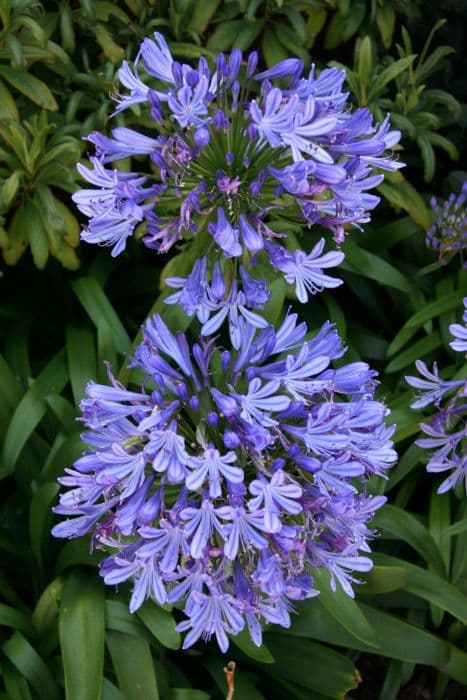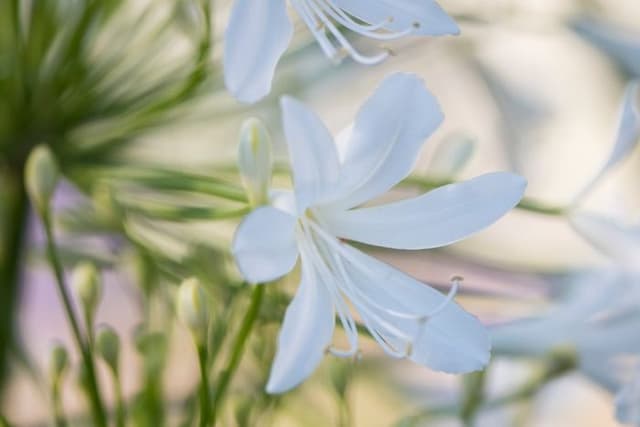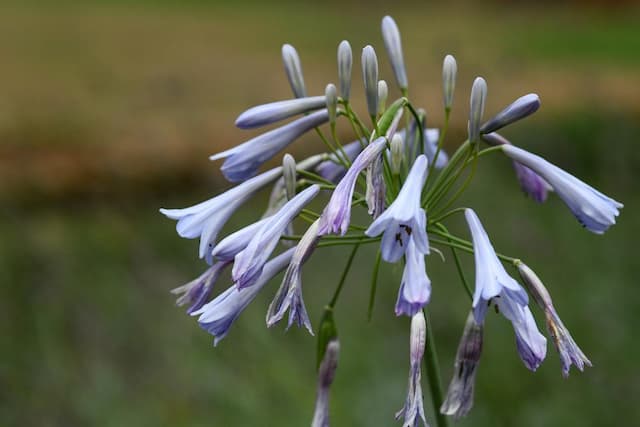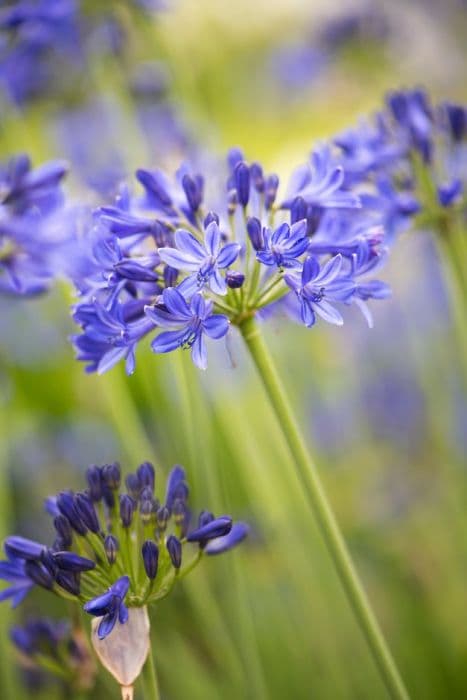African Lily Agapanthus 'Windsor Grey'

ABOUT
Agapanthus 'Windsor Grey' is a striking perennial known for its lush and strap-like foliage that creates an elegant, fountain-like clump of greenery. It is acknowledged for its distinctive flower heads which emerge on tall, sturdy stalks that rise magnificently above the foliage. Each flower head is composed of numerous small, trumpet-shaped blossoms that are a soft grey color, a hue that is quite unusual and sophisticated in the world of flowers. These blossom clusters have a rounded, globular form and provide an impressive display when the plant is in bloom. The overall effect of the Windsor Grey is one of subtle elegance and unique charm, with its grey flowers contributing a cool, serene hue that combines beautifully with other plants in a garden setting. Despite the name 'grey,' these blossoms may have tinges of blue or lilac, depending on the light and growing conditions, adding to the complexity and allure of the plant. The foliage of the Windsor Grey typically remains attractive even when the plant is not in flower, making it a valuable addition to any landscape for its structure and color.
About this plant
 Names
NamesFamily
Amaryllidaceae.
Synonyms
Lily of the Nile, African Lily.
Common names
Agapanthus 'Windsor Grey'
 Toxicity
ToxicityTo humans
The Agapanthus, sometimes referred to as Lily of the Nile, is considered mildly toxic to humans if ingested. It contains substances that can cause symptoms such as nausea, vomiting, and diarrhea. Skin contact with the sap may also cause irritation or allergic reactions in some individuals. It is advisable to exercise caution and keep all parts of the plant away from children who might accidentally ingest it.
To pets
The Lily of the Nile is also toxic to pets, including cats and dogs, if any part of the plant is ingested. The toxins can lead to gastrointestinal symptoms such as vomiting, diarrhea, and abdominal pain. In some cases, excessive drooling and lethargy may also be observed. It's important to prevent pets from chewing on or ingesting any portion of the plant, and to seek veterinary care if exposure is suspected.
 Characteristics
CharacteristicsLife cycle
Perennials
Foliage type
Evergreen
Color of leaves
Green
Flower color
Grey
Height
2 feet (0.61 meters)
Spread
2 feet (0.61 meters)
Plant type
Bulb
Hardiness zones
8
Native area
South Africa
Benefits
 General Benefits
General Benefits- Attractive Flowers: Agapanthus 'Windsor Grey' produces elegant greyish-blue flowers that add a unique aesthetic appeal to gardens.
- Drought Tolerance: Once established, it can tolerate dry conditions, making it suitable for water-wise gardens.
- Low Maintenance: This plant requires minimal care once it's settled, with occasional watering and feeding.
- Long Blooming Season: The plant has a long flowering period that lasts throughout the summer months.
- Deer Resistance: It's known to be resistant to browsing by deer, which is beneficial in areas where deer are a common garden pest.
- Attracts Pollinators: The flowers attract bees and butterflies, which are essential for pollination and the overall health of the garden ecosystem.
- Good for Borders: It works well when planted in borders due to its clumping habit and attractive foliage.
- Container Gardening: Agapanthus is also well-suited to container gardening, allowing for versatility in placement and design.
- Erosion Control: The root system of agapanthus helps to stabilize the soil, reducing erosion on slopes.
- Architectural Form: With its striking floral display and foliage, it offers an architectural form that can act as a focal point in garden design.
 Medical Properties
Medical PropertiesThis plant is not used for medical purposes.
 Air-purifying Qualities
Air-purifying QualitiesThis plant is not specifically known for air purifying qualities.
 Other Uses
Other Uses- Photography Prop – The striking greyish hue of the Agapanthus 'Windsor Grey' blooms can serve as an elegant backdrop or feature in garden photography and art photography.
- Fabric Dye – The flowers, when processed correctly, have the potential to be used as a natural dye for textiles, imparting subtle hues.
- Ink Making – Similarly to fabric dye, the petals of Agapanthus may be boiled down to create a natural ink for arts and crafts.
- Culinary Garnish – Although not widely known as an edible flower, the Agapanthus blossom can be used as a non-toxic decorative garnish for dishes.
- Educational Resource – This plant can be used in educational settings to teach children and students about botany and plant life cycles.
- Craft Material – Dried flowers and seed pods can be used in craft projects, such as in the making of wreaths or dried flower arrangements.
- Event Decorations – The flowers of the Agapanthus can be used to create natural and elegant table centerpieces for weddings and other events.
- Testing Soil pH – The color intensity of the flowers may vary with the acidity or alkalinity of the soil, thus serving as an informal indicator of soil pH.
- Biodegradable Confetti – Dried petals of Agapanthus can be scattered as a biodegradable option for confetti at celebrations.
- Boundary Plant – The Agapanthus can be used to demarcate boundaries in a garden due to their dense foliage and height.
Interesting Facts
 Feng Shui
Feng ShuiThe Lily of the Nile is not used in Feng Shui practice.
 Zodiac Sign Compitability
Zodiac Sign CompitabilityThe Lily of the Nile is not used in astrology practice.
 Plant Symbolism
Plant Symbolism- Love Letters: Agapanthus, also known as Lily of the Nile, often symbolizes love letters or love messages, as its name is derived from the Greek words 'agape,' meaning love, and 'anthos,' meaning flower.
- Enduring Love: With its lengthy bloom period and perseverance, it represents the endurance of love over time.
- Beauty: The striking appearance of the Agapanthus flowers suggests beauty and uniqueness.
- Fertility: In some cultures, the prolific nature of the plant's blooming is associated with fertility and creation.
 Water
WaterAfrican Lilies should be watered thoroughly once the top inch of the soil feels dry to the touch. This typically means watering every week during the growing season; however, the frequency may need to be adjusted depending on temperature and humidity. Ensure the plant receives about one gallon of water per watering session to saturate the root zone. During the winter months, reduce watering to every two to three weeks, as the plant requires less moisture when it's not actively growing. Always avoid waterlogging by ensuring that any excess water can drain away effectively.
 Light
LightAfrican Lilies thrive best in full sun to partial shade. They prefer a location where they can receive at least six hours of direct sunlight daily, but they can tolerate some light dappled shade, especially in hotter climates. Avoid deep shade, as it will lead to reduced flowering and poor plant vigor.
 Temperature
TemperatureAfrican Lilies prefer temperatures in the range of 60°F to 80°F but can survive in temperatures as low as 50°F. They can withstand brief periods of cooler weather, but extended exposure to temperatures below 50°F can be harmful. Ideally, keep them in a location where the temperature is consistently within their comfort range to promote healthy growth.
 Pruning
PruningPrune African Lilies to remove spent flower stalks and encourage reblooming. After the main summer bloom, cut back the flower stems to the base. In late fall or early spring, tidy up the plant by removing any dead or damaged leaves. Pruning is usually done annually or as needed when the plant appears untidy.
 Cleaning
CleaningAs needed
 Soil
SoilAfrican Lily thrives in a well-draining soil mix with a pH of 6.0 to 6.5. A mixture of two parts loam, one part peat or compost, and one part sharp sand or perlite is ideal, promoting healthy root growth and adequate drainage. Regular feeding during the growing season can support robust blooms.
 Repotting
RepottingAfrican Lily typically needs repotting every 2 to 3 years or when it becomes root-bound. It's best to repot in the spring before the growing season, using the soil mix recommendation and ensuring the new pot has ample room for root growth without being excessively large.
 Humidity & Misting
Humidity & MistingAfrican Lily prefers moderate humidity levels, around 40-60%. It can tolerate some dry air but maintaining humidity in this range can help prevent tip burn and encourage healthy foliage and flower development.
 Suitable locations
Suitable locationsIndoor
Place in bright, indirect light and water moderately.
Outdoor
Plant in a sunny spot, sheltered from strong winds, and mulch.
Hardiness zone
8-11 USDA
 Life cycle
Life cycleThe Agapanthus 'Windsor Grey', also known as Lily of the Nile, begins its life cycle as a seed, which germinates in warm, moist soil conditions, sprouting into a seedling with basic root structure and foliage. As it enters the vegetative stage, it develops a more robust root system and abundant strap-like leaves, maturing over several months. During the flowering stage, typically in summer, the plant sends up tall flower stalks topped with globular clusters of trumpet-shaped, pale silver-grey flowers. After pollination, which is often aided by insects, the flowers give way to seed pods that eventually dry and release seeds for the next generation. In the absence of pollination, Agapanthus can also propagate vegetatively through division of its rhizomatous root system, creating clones of the parent plant. The plant enters dormancy in colder seasons, reducing its metabolic activities until favorable growing conditions return.
 Propogation
PropogationPropogation time
Spring-Early Summer
The most popular method of propagation for the Agapanthus 'Windsor Grey', commonly known as African Lily or Lily of the Nile, is by division. This is ideally done in the spring or early summer when the plant is beginning to actively grow. To propagate by division, carefully dig up the plant and gently separate the clump into smaller sections, ensuring that each division has a portion of the root system intact. These sections can then be immediately replanted in well-draining soil, spaced about 18 to 24 inches (approximately 45 to 60 cm) apart to allow for adequate room for growth. Water the new plants thoroughly after planting to help establish them. It's important to note that the divided plants may take a year or two to bloom abundantly, as they first focus on establishing their root systems in their new locations.









